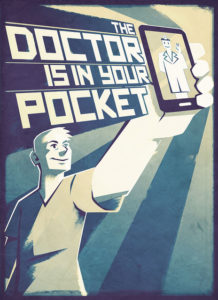 The past few months has seen an explosion of digital therapeutics progressing with their paths-to-market. When I look across the offerings, I see three big insights driving the success of these therapeutics. Though I do think there are still opportunities to disappoint, especially around one particular area (that’s the warning).
The past few months has seen an explosion of digital therapeutics progressing with their paths-to-market. When I look across the offerings, I see three big insights driving the success of these therapeutics. Though I do think there are still opportunities to disappoint, especially around one particular area (that’s the warning).
Insights
1) Better than a pill: Many of the digital therapeutics coming to market around behavioral health show how something digital can be better than the usual therapy or even just a pill. Many of these apps revolve around cognitive behavioral therapy (CBT), which lends itself well to codification into a long-term digital engagement platform.
Also, the benefits of digitizing a therapy protocol provides better measurement of benefit and tweaking of engagement, more so than episodic visits to a live therapist. This isn’t rocket science, but you still need to nail the experience (see more below).
2) More than a pill: Often app makers think their therapy can stand on its own. But in behavioral health, the combination of drug and therapist is always better than drug alone. And it seems that behavioral health digital therapeutics can get the same benefit.
Indeed, the most excitement will be in digital therapeutics as “pill-plus”, where the app is used in conjunction with the drug, as a companion or wrap-around to augment and deliver the therapeutic effect.[1]
By the same model, digital therapeutics should consider “people-plus”, where the app can complement and be an integral part of the therapies given by real people. And it seems that the more interesting digital therapeutics are doing just that.
3) Just like a pill: These apps are for making people better. If you fail, folks get hurt. Therefore, digital therapeutics still need to prove effectiveness.[2]
And digital therapeutics are just another form of a therapy, so it’s good to see that companies like Pear Therapeutics and Click Therapeutics look, feel, and smell like a pharma and have execs from the pharma space. Check out this pipeline view from Click. And here is some reporting on the results of their therapy validation activities. Just like any pharma.
Take this view further and these digital therapeutics will also need proper commercialization and positioning to succeed, just like the usual pharma.[3]
Warning
Those are three insights that are essential for further growth of digital therapeutics. But there is still room for disappointment, hence the following warning.
You still need to bring value to patient and nail the experience: Design and engagement are going to make or break these therapeutics. Indeed, poor design is leading to poor engagement with behavioral health apps and a high abandonment rate.[4]
We already know folks really don’t engage in the pills that keep them alive (at least as indicated by adherence and prescription fulfillment stats). The good thing is that the extent to which folks have engaged with mobile apps suggests that digital therapies might have a leg up on engagement versus pills and devices.
Though, beware of relying on the levels of engagement seen during digital therapeutic trials as an indicator of engagement in the real world. Folks in trials are usually better monitored and incentivized to use the therapy. The challenge is when users are not. Observing the Real World Evidence is as important in digital as in non-digital therapies in the market and in live use. Just like in usual pharma.
What do you think? Are you designing a digital therapeutic? What is your design process? How will you be going to market? I’m curious to know.
Endnotes (because I’m a nerd)
[1] Though do not, do not, do not relegate the app to an adherence tool.That would be futile. No adherence app!
[2] There’s a reason why all the orgs in the Digital Therapeutic Alliance need to have clinically validated therapies to even be part of the alliance.
[3] Which is why I partnered with IDEA Pharma, who has been behind the positioning and commercialization of a ton of block-busters, to expand our capabilities to ideate paths-to-market, positioning, and commercialization of digital therapeutics.
[4] Over the past 20 years or so, I’ve been evaluating, building, and going to market with mobile solutions. I’m still amazed that we need to continuously point out the value of good design and user engagement.
Health Axiom from Juhan Sonin
updated 11jul18: changed first links in first sentence to a more comprehensive update on latest news in this space